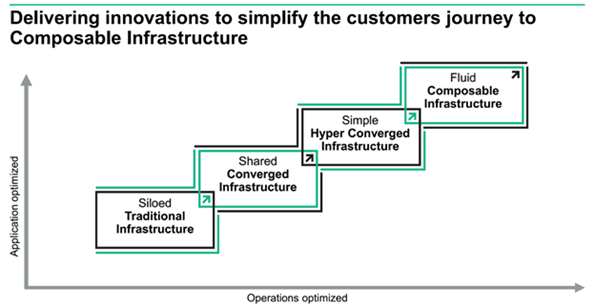HPE Cloud Day 2016, Part II: HyperConverged Infrastructure
HPE and HyperConverged Systems
Funny thing about HyperConverged: there are one or two firms actually delivering innovation, and innovative products in this space, of which only Nutanix readily comes to mind. The rest of the crowd are largely using the ‘hyper-converged’ buzzword to verbally modernize their lame, tired offerings.
Standing apart from these clowns however, is HPE.
HPE’s path to datacenter infrastructure hyperconvergence and beyond is not new.
HPE publicly unveiled, and has been talking about the converged datacenter since 2009, when then-HP SVP Ann Livermore announced HP Converged Infrastructure Architecture.
Funny how time flies. The vision that seemed rather esoteric then is now de rigeur, has been bypassed by HyperConverged, and is now at composable.
With HyperConverged systems coming to the fore, choices have to be made that reflect true infrastructure convergence. It is not enough to take a rack, insert whitebox servers into it, generic storage appliances, slap any common top-of-rack networking module on it, and call it “hyper-converged”.
That, it isn’t.
HyperConverged requires a dedicated set of products working in sweet symphony to deliver orchestration and deployment that can be equally easily managed.
As a result of that Converged Infrastructure vision, HPE products have gained individual intelligence and remote manageability over the intervening iterations.
This hasn’t been by accident: intelligence in almost every strata of the hardware means that the manager has a greater visibility into the underlying infrastructure, allowing for easier, more reliable hyper-converged implementations to occur.
Why HPE for HyperConverged?
Simple: they’re iterating faster, and have a roadmap that, while continually evolving, allows you to retain the value of your investments in their products.
HP’s first product was the HyperConverged 200 StoreVirtual. This product combined compute, storage, networking, and VMware in a preconfigured package. Based on a Proliant, and housed in a 2U rack, the HC200 contained 4 servers.
The follow-on product, and improvement on the HC-200 was the HPE Hyper Converged 250 system, especially the version of HC-250 that comes with Microsoft Cloud Platform System, aka, the one which replaces VMware with Microsoft Hyper-V/Microsoft Azure Pack.
While a plurality of the server virtualization uses VMware, for us, it is Hyper-V and Azure. That makes this product one to look at, and look out for when building out hybrid clouds for clients.
Today, HPE has the Hyper Converged 380. Using the underpinnings of the venerated HP Proliant DL380, the HC 380 ramps up performance even more, utilizing the latest Intel Xeon E5 CPUs, NVIDIA coprocessors, 128-768 GB R-DIMM, or 1024-1536 GB LR-DIMM, the same 2U form factor, and more.
At this time, I don’t believe Microsoft CPS is supported. However, I am awaiting a reply to my enquiry on that.
As I see it….
The brainmap image above says it all: the days of siloed, and traditionally outfitted datacenters are over. In fact, basic converged infrastructure implementations are just about at end-of-life.
Any new, or improvement to your datacenter has to start at hyper-converged in order to be future-proof, and for both capex, and operational financial efficiency.
Reliability, and speed of service delivery to your users will be vastly improved as well.
Interestingly, costs of entry seem to be normalized relative to basic systems, and not priced as the loops at #1, Infinite Loop, in Cupertino, would have priced such innovations.
Today, now, you have no excuse for not going with hyper-converged.
And for just about all of us, HPE HyperConverged is the only reasonable choice.
* Much thanks to Calvin Z.(@calvinzito) for his info on the genealogy of the HPE Hyper Converged appliances
© 2002 – 2016, John Obeto for Blackground Media Unlimited
Follow @johnobeto

